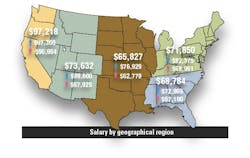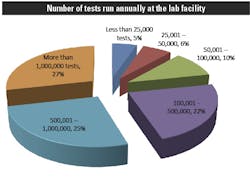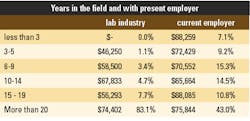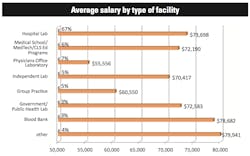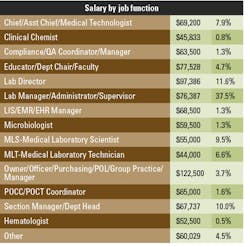Annually, Medical Laboratory Observer polls our readership with our salary survey. The survey gives us a good picture of salary trends, education, certifications, and the places our laboratorians work. This year’s average salary is $71,861, about a 1.7% increase over 2012. Respondents were split between 76% female with average salaries of $68,757, and 24% male with an average of $81,798.
We had a strong response rate at 17% with 379 subscribers taking time to answer our survey. Thanks to all who gave of their time so we could present this snapshot. We would also encourage readers to share any comments and reactions by emailing [email protected].
Age distribution and comparison
We can see the retirement cliff not too far ahead with an average age of 53.3—exactly one year older than last years average. Respondents from ages 26 to 35 make up a very small percentage of the whole—3.4%. The 36-to-45-year-old group also comprises a relatively small slice of the pie: 13.5%. Laboratorians in the age range of 46 to 55 come in at 37.2%. Last year’s survey indicated that 39% of respondents were in the 56-to-65-year-old age group, the largest cohort, and this year’s results show 42% in that age range—those marching slowly but surely toward retirement. Responders age 66 and older comprised 2.9% of the total—the smallest group.
Gender, education, and salary
It is not surprising that salaries generally increase with length of service—though, note that the differences are minor when the 26-35, 36-45, and 46-55 groups are compared, and that our respondents age 36 to 45 actually had a slightly lower average salary (by $938 annually) than their counterparts in the 26-35 group. Notice too, that respondents over 65 broke the six-figure barrier, with room to spare (average salary, $109,909).
The average salary was $51,862 for laboratorians with an Associate degree; $78,481 for those with a Bachelor’s degree; and $81,923 for those who hold a post-graduate degree. The largest percentage of laboratorians (61.7%) holds a Bachelor’s degree.
Annual salary figures favor men among the very small group of technicians who are high school graduates. On average, male survey respondents in that category earned $62,500, while women earned $53,333.
The gender disparity is surprising and reminds us that the clinical laboratory profession, like most professions, still has a way to go in righting this historic wrong. Women who have earned an Associate degree average a salary of $49,390, compared to $68,750 for men—a very significant difference. Wages for women with Bachelor’s degrees are also significantly lower than wages for men with Bachelor’s degrees: $70,622 (women) and $78,830 (men). Women with post-graduate degrees also earn less than men: $77,908 on average, to $89,694.
Increases and benefits
Overall, salaries stayed the same for 34.4% of respondents, 1.8% experienced a decrease, and 63.8% received an increase, averaging 2.5%. Respondents report that 69.8% expect a raise this year—though more than 90% of those expect an increase of no more than 4%. More than 44% receive overtime pay, and 17% can take advantage of flextime. Bonuses were given to 29.6%.
How much “hidden” money is available in your paycheck? Respondents report the following benefits: 97% have access to healthcare insurance, 91.6%, have the opportunity to invest in 401K or pension plans, 94.2% have the option of dental insurance, 87.1% have life insurance, 76.5% are eligible for disability, and 6.8% have access to childcare. Overall, comparing 2013 to 2012, benefits showed decreases in access to healthcare insurance by 2.3%, opportunity to invest in a 401K by 3.6%, disability insurance by 6%, and access to childcare by 2.3%.
And being a salaried employee is still an advantage for the 56.2% salaried laboratorians who had average salaries of $81,687 versus the 43.8% hourly employees with average pay of $59,111. However, a quick disclaimer: we cannot verify that all of those hourly lab professionals are working the same amount of hours as their salaried counterparts. Our poll showed that 59.4% work an eight-hour shift, but 32.2% work more hours.
Years in the field and with present employer
Eighty-three percent of respondents have been employed in the lab industry for more than 20 years and 43% have stayed with the same employer. On the other end of the spectrum, we find only 1% of the three-to-five-year respondents new to the industry, and of that group 9% have not changed employers.
Salary by geographical region
The figures show significant disparities in salary in the different regions of the United States. There was a decline from last year’s survey numbers in the Northeast (from $74,231 to $71,850) and Central (from $66,933 to $65,827). The Pacific region has remained the highest-paying with $97,218—a substantial increase over last year, when the average for that region was $82,109. In the Mountain region the average wages are $73,632, an increase over last year’s figure of $68,130. That increase put the Mountain region ahead of the Southeast ($68,784, as opposed to $68,268 last year). It is not easy to know why we see unanticipated disparities, but the average may be affected by local factors in specific areas.
Continuing education and certifications
Professional development is crucial to healthcare professionals and often measured in educational certifications. The majority of certifications reported by our MLO respondents were for Medical Technologist (MT) with 78%; next highest was for Medical Laboratory Technician (MLT) at 19%. Some 17% of respondents were certified as Clinical Laboratory Scientists, and 13% as Medical Laboratory Scientists.
Among the professional organizations that certify laboratorians, respondents indicated that 86% were certified by the American Society for Clinical Pathology (ASCP), and 15% by the National Credentialing Agency for Laboratory Personnel.
Automation and annual number of tests
We asked respondents to tell us what impact medical personnel shortages had on lab efficiency: 35% said “low,” 38% said “moderate,” 9% said “large,” and 18% indicated that in their experience it had no impact. We also asked respondents if their lab outsourced work, and 89.9% said “no,” while 10.1% said “yes.” Automation was employed by more than half the labs, with 51.1% saying their labs used automated procedures/products, and 48.9% reporting that their labs did not.
Our respondents noted that efficient operation is always essential, especially for larger labs (27%) performing more than one million tests each year.
The typical laboratorian: a statistical view
According to MLO’s survey respondents, a representative laboratory professional is a female, 56 to 65 years old, who works in Texas. She has a supervisory position (37.5%) as a lab manager/administrator/supervisor, in a hospital lab (66.8%), is salaried (56.2%), and generally works an eight-hour shift (59.4%). Her salary is $71,717.
Our “typical” clinical lab pro works for an organization with 21 to 50 employees (25.3%). She is a graduate of a college or university (64%) and is certified in her field (86%). She participates in a continuing education program, taking almost nine CE classes yearly, and she is professionally certified by the American Society for Clinical Pathology (ASCP). She has worked in the clinical laboratory field for more than 20 years (83.1%), and has been with her current employer for more than 20 years (43%).
Security and satisfaction
Respondents to the MLO survey indicate a slight change in security and satisfaction from last year. More than 93% reported they felt secure in their jobs last year, as opposed to 91.7% this year. More than 90% said they were satisfied last year; this year the number was 89.1%.

